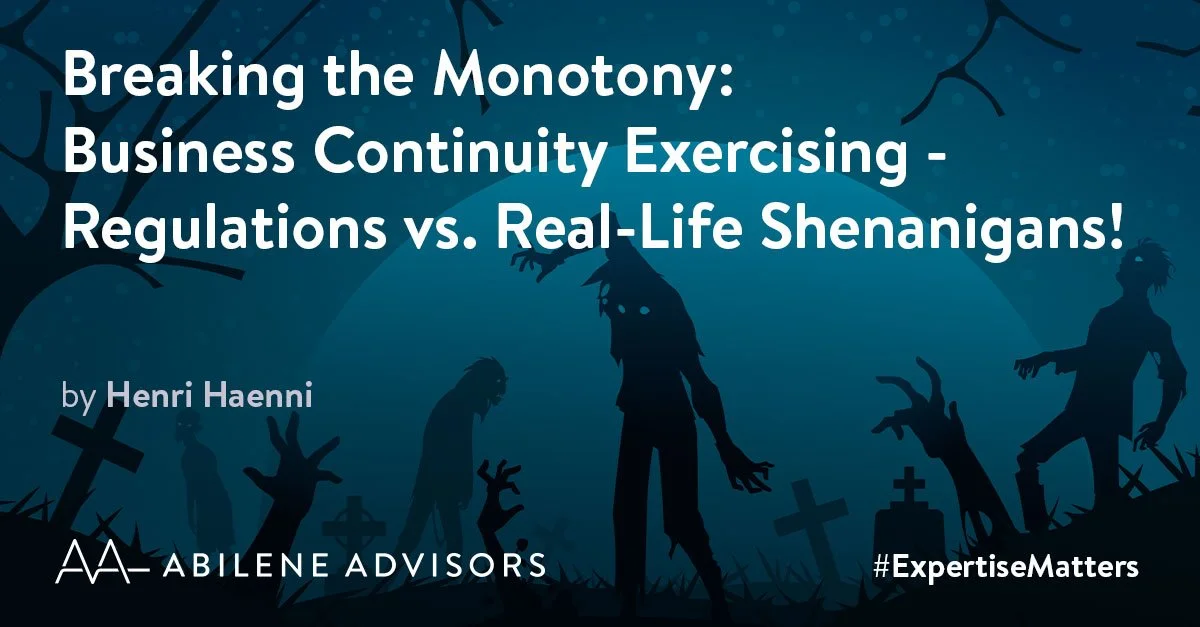Breaking the Monotony
In the world of business continuity, every year, there’s a peculiar dance that organizations must perform—a dance that involves complying with regulations while also ensuring that their plans are not just pieces of paper gathering dust. It’s a balancing act between the bureaucratic requirements (yes, admit it!) and the need to fire test those plans against real-life tangible scenarios. Buckle up, folks, as we are going to dive into the wacky world of business continuity exercising.
Just picture this: a stern regulator striding into your organization, verifying that you comply with every last detail of the business continuity regulations (those of you in the banking industry will know what I am talking about). They drone on about audits, documentation, and checkboxes, leaving you in a state of regulatory-induced coma. Hold on a minute! Are we here to comply or to ensure our plans work when the rubber hits the road? Both actually !!
That’s where business continuity exercising comes into play. It’s like injecting a much-needed dose of reality into the seemingly mundane world of regulatory compliance. It’s the moment when you throw caution to the wind, break free from the shackles of bureaucracy, and let your imagination run wild. Get your hands in the mud… Who said business continuity can’t be fun?
Let’s talk about those regulations for a moment. Yes, they are important, providing a (sometimes rigid) framework to ensure organizations have a plan in place. But here’s the funny thing: regulations often sound like they were written to apply to an incredibly vast array of organizations, disregarding their own culture, conditions, size, and capacities. You’ve had the impression that these regulations were developed by stubborn bureaucrats who’ve never had a full grasp of reality?
So, how do we bridge the gap between the regulations and real-life business continuity? Enter the realm of creative exercising scenarios. Do not restrain yourself, brainstorm with your peers and don’t be afraid to put up with all sorts of ridiculous ideas. After all, in the last 3 years, we had no less than a pandemic that froze the world for half a year, too-big-to-fail banks going bankrupt, threats of major regional blackouts, the rise of AI and an anachronic war. It certainly opens the doors of imagination, doesn’t it? So, what is left? Why not alien invasion or zombie apocalypse?
Ok, being serious now: while some may argue that overly creative scenarios are frivolous and lack seriousness, we beg to differ. Business continuity exercises MUST be fun, memorable, engaging, and dare I say, a little bit absurd. I have noticed in my multiple exercises experiences that, surprisingly, utterly realistic scenarios are actually not promoting engagement but rapidly boring everyone to indifference. And instead of being a memorable experience, with lessons learned (and remembered), it becomes a painful chore and any learning rapidly sinking in the dark depths of oblivion.
It’s not about scaring your employees or creating chaos; it’s about injecting a sense of urgency and healthy stress, testing their ability to think on their feet and out of the box, and bringing out their hidden talents, like, why not, negotiating with aliens or mastering zombie slaying techniques (all while restarting operations).
But let’s not forget the purpose behind the fantasy. Business continuity exercises provide invaluable insights into the effectiveness of your plans. They reveal gaps, highlight dependencies, and uncover the unexpected. In the midst of all the fun, there’s a serious purpose—to ensure that when a real crisis strikes (and certainly not one of your predefined scenarios), your organization is prepared to boldly fight against the unknown and ready to bounce back.
So, the next time you find yourself drowning in a sea of (sometimes even contradicting) regulations, remember the importance of business continuity exercising. Embrace the absurdity. Exercise your plans against outrageous scenarios, because when it comes down to it, real-life disruptions are rarely predictable or dull (would you need plans if they were?).
Break free from the monotony, inject a healthy dose of imagination into your business continuity exercises. Welcome the quirks, challenge the regulations, and ensure your plans are not just fit-for-purpose, but fit-for-life’s-crazy-moments.
Remember, business continuity doesn’t have to be a snooze-fest. It can be a wild journey, filled with creativity and very gratifying for all the participants. So, gear up, get your team ready, and let the fun of business continuity exercising begin!

